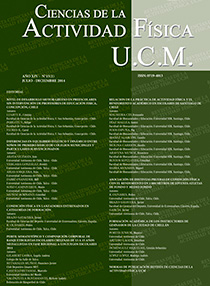Relación de la práctica de actividad física y el rendimiento académico en escolares de Santiago de Chile
Contenido principal del artículo
Resumen
Detalles del artículo
Adlard, P. & Cotman, C. (2004). Voluntary exercise protects against stress-induced decreases in brain-derived neurotrophic factor protein expression. Neuroscience, 124 (2004), 985–992.
Angevaren, M., Aufdemkampe, G., Verhaar, H., Aleman, A. & Vanhees, L. (2008). Physical activity and enhanced fitness to improve cognitive function in older people without known cognitive impairment. Cochrane Database Syst Rev., 3.
Davis, C., Kennedy, S., Ravelski, E. & Dionea M (1994). The role of physical activity in the development and maintenance of eating disorders. Psychological Medicine; 24, 957-967.
Davis, C.L, Tomporowski, P.D, Boyle, C.A, Waller, J.L. Miller, P.H, Naglieri, J.A, Gregoski, M. (2007). Effects of aerobic exercise on overweight children’s cognitive functioning: A randomized controlled trial. Research Quarterly for Exercise and Sport 78 (5), 510-519.
Denckla, M. (1996). Research on executive function in a neurodevelopmental context: Application of clinical measures. Development Neuropsychology, 12 (1), 5-15.
Dunn, A., Trivedi, M. & O’Neal, H. (2001). Physical activity dose-response effects on outcomes of depression and anxiety.Medicine & Science in Sports & Exercise, 33, 587-97.
Dwyer, T.; Sallis, J.; Blizzard, L.; Lazarus, R.; Dean, K. (2001), Relation of academic performance to physical activity and fitness in children. Pediatric Exercise Science, 13, 225-237.
Erickson, K., Voss, M., Prakash, R., Basak, C., Szabo, A., Chaddock, L., Kim, J., Heo, S., Alves, H., White, S., Wojcicki, T., Mailey, E., Vieira, V., Martin, S., Pence, B., Woods, J., McAuley, E. & Kramer, A. (2011). Exercise training increases size of hippocampus and improves memory. Proceedings of the National Academy of Sciences, 108 (7), 3017-3022
Ferreyra, J.; Di Santo, M.; Morales, M.; Sosa, M.; Mottura, E. & Figueroa, C. (2011). Efecto agudo y crónico del ejercicio físico sobre la percepción-atención en jóvenes universitarios. Calidad de Vida, 3, (6), 103-136.
Fredericks, C.; Kokot, S.; Krog, S. (2006). Using a developmental movement programme to enhance academic skills in grade 1 learners. S Afr J Res Sport Phys Educ Recreation. 28(1), 29-42.
Gall, H. (2000). Proyecto Escuela en Movimiento. Universidad Pedagógica de Ludwigsburg. Alemania.
Held, R. & Hein A. (1963). Movement-produced stimulation in the development of visually guided behavior. Journal of Comparative and Physiological Psychology 56, (5), 872-876.
Lezak, M. D. (1983). Neuropsychological assessment. New York: Oxford University Press.
Linder, K. (1999). Sport participation and perceived academic performance of school children and youth. Pediatric Exercise Science, 11, 129-144.
Nelson, M.; Gordon-Larsen, P. (2006). Physical activity and sedentary behavior patterns are associated with selected adolescent health risk behaviors. Pediatrics, 117(4), 1281-1290.
Papazian, O.; Alfonso, I.; Luzondo, R. (2006). Trastornos de las funciones ejecutivas. Revista de Neurología, 42 (Supl 3), S45-S50.
Ramírez, W.; Vinaccia, S. & Ramón, G. (2004). El impacto de la actividad física y el deporte sobre la salud, la cognición, la socialización y el rendimiento académico. Revista de Estudios Sociales, 18, 67-75.
Reyes, A. (2009). La implicancia de la neurociencia en la ejecución gimnástica. Sapiens, 10, (1), 179-201.
Salas, R. (2003). ¿La educación necesita de la neurociencia? Estudios Pedagógicos, 29, 155-171.
Singh, A., Uijtdewilligen, L., Twisk, J. W., van Mechelen, W., & Chinapaw, M. J. (2012). Physical activity and performance at school: a systematic review of the literature including a methodological quality assessment. Archives of Pediatrics & Adolescent Medicine, 166 (1), 49-55.
Sonstroem, R. (1984). Exercise and self-esteem exercise. Sport Science Review 12, 123-155.
Trejo, J.; Carro, E.; Garcia-Galloway, E. & Torres-Aleman, I. (2004). Role of insulin-like growth factor I signaling in neurodegenerative diseases. J Mol Med., 82, 156-162.

Esta obra está bajo una licencia de Creative Commons Reconocimiento-CompartirIgual 4.0 Internacional

